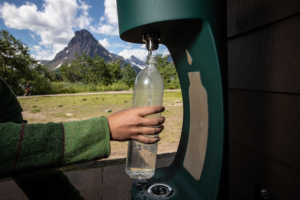Stanford’s New Powder Disinfects Contaminated Drinking Water
 With more than 2 billion people lacking access to safe drinking water, the challenge of water scarcity looms large. According to UNICEF, nearly half of the global population could face water scarcity by 2025. To address this impending crisis, researchers at Stanford University are pioneering a novel approach: a powder that swiftly purifies contaminated water. Unlike conventional methods, this innovative solution utilizes sunlight to eliminate bacteria within a minute. The introduction of innovative solutions like Stanford’s powder presents a pathway toward achieving widespread and enduring access to clean drinking water.
With more than 2 billion people lacking access to safe drinking water, the challenge of water scarcity looms large. According to UNICEF, nearly half of the global population could face water scarcity by 2025. To address this impending crisis, researchers at Stanford University are pioneering a novel approach: a powder that swiftly purifies contaminated water. Unlike conventional methods, this innovative solution utilizes sunlight to eliminate bacteria within a minute. The introduction of innovative solutions like Stanford’s powder presents a pathway toward achieving widespread and enduring access to clean drinking water.
The Study
On May 18, 2023, Stanford University published results from their study about a powder that disinfects contaminated drinking water. The technology is unique because it reacts with the sun’s UV rays and “high-energy visible light.” It then creates chemicals that attack bacteria’s cell membranes to kill them. Scientists found that the powder is so effective it can disinfect drinking water in just 60 seconds.
Stanford’s new powder is made from metallic “nano-sized flakes of copper, iron oxide, aluminum oxide and molybdenum sulfide” that are cost-effective and readily available. The product is sustainable because the metals are easy to make and reuse. A magnet collects the metallic “nanoflakes” from clean water, then places them in new contaminated water. The water is safe to drink immediately after decontamination due to the chemical byproducts breaking down into water and oxygen. In the study, one dose of recycled powder disinfected 30 water samples. Since water treatments are scarce, reusing the product allows people to have longer access to clean water.
This is great progress because current treatments add chemicals that leave behind toxic byproducts and utilize ultraviolet light, which requires electricity. And these constraints make it difficult to implement water treatments on a large scale.
Water Scarcity
In areas where water is scarce, there are few opportunities to find a source of safe drinking water. Consuming contaminated water exposes people to preventable diseases such as diarrhea, typhoid and cholera. Diarrhea causes an estimated 446,000 deaths per year among children younger than 5 years old, or 9% of all deaths for children in that age range. Adequate access to clean water allows for better hygiene and sanitation practices.
The scientists used E. coli in their study, which is a widespread contaminant that causes fecal-oral diseases. With 1.7 billion children younger than 5 years old suffering from diarrhea, this technology could provide relief from preventable waterborne illnesses.
Looking Toward the Future
Stanford University’s groundbreaking powder has the potential to revolutionize clean drinking water access for the approximately 2 billion individuals worldwide who lack it. Furthermore, the wide distribution of this powder could enable those already using water treatments to embrace improved hygiene and sanitation practices. Notably, gaining access to a consistent and safe water source significantly enhances individuals’ health and overall quality of life.
Tong Wu, the co-lead author of the project, expressed, “We believe that our novel technology will facilitate revolutionary changes in water disinfection and inspire more innovations.” This recyclable and nontoxic powder represents a pioneering development. The powder’s scalability and distribution potential render it a viable and practical solution for individuals facing restricted access to safe water sources.
– Diana Grant
Photo: Flickr
